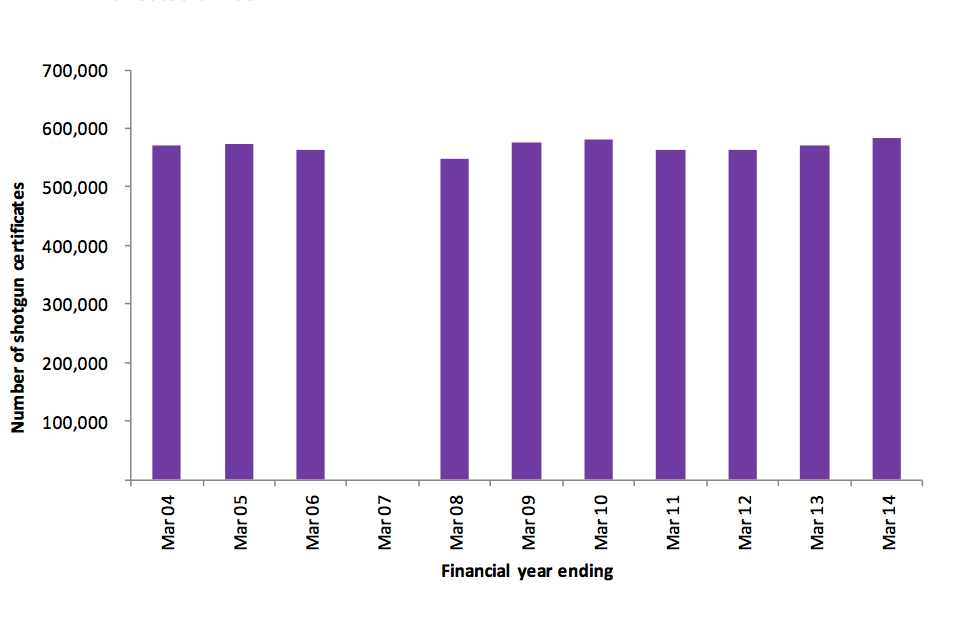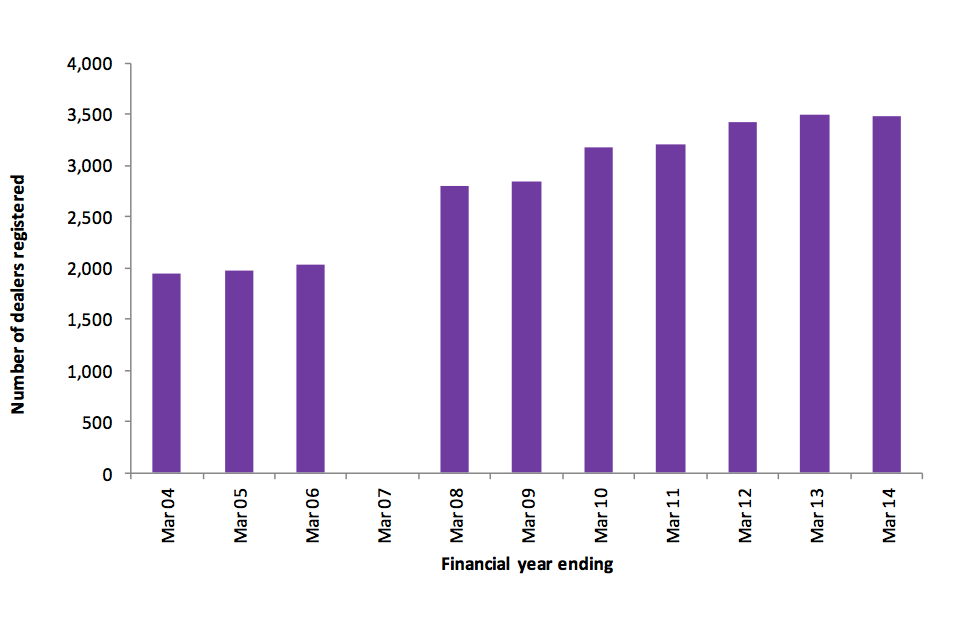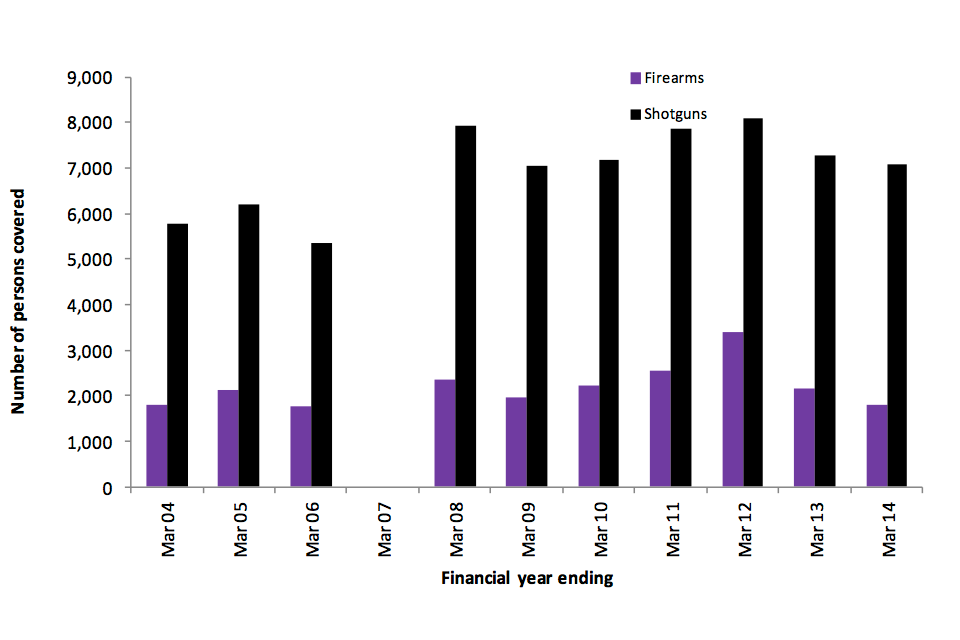Firearm and shotgun certificates in England and Wales financial year ending March 2014
Published 7 August 2014
Applies to England and Wales
1. Introduction
Information is presented here on firearm and shotgun certificates issued by police forces in England and Wales under the Firearms Acts 1968 to 1997. It covers certificates on issue as at 31 March 2014, as well as historical trend data and police force comparisons. The statistical release also provides information on the number of certificates granted and refused for new and renewal applications during the financial year ending March 2014 as well as information on the number of registered firearm dealers, visitors’ permits, European firearm passes (EFP) and Article 7 Authorities issued.
The data were extracted from the National Firearms Licensing Management System (NFLMS), which is a register of all persons who have applied for a certificate to possess or acquire a firearm or shotgun, on 1 April 2014.
The user guide provides information about the history of the data collections, NFLMS and details relating to definitions and legislation covering the licensing of firearms.
Key facts
- There were 151,413 firearm certificates on issue as at 31 March 2014, an increase of 2.5% compared with 147,695 on issue at the end of March 2013.
- The number of firearms covered by such certificates increased in the last year (to 507,867 firearms) and is the highest number since these figures were first collected in 1995.
- There were 582,923 shotgun certificates on issue as at 31 March 2014, an increase of 2.1% from the 570,726 on issue at the end of March 2013.
- There were 8,930 new firearm certificates granted in the year ending March 2014, a decrease of 11.4% from the 10,077 in the previous year.
- There were 23,680 new shotgun certificates granted in the year ending March 2014, a 10.4% decrease compared with the previous year when 26,429 were granted.
- Around 1.5% of new applications for firearm certificates and 2.8% of new applications for shotgun certificates were refused in the year ending March 2014.
- A total of 402 firearm certificates and 1,377 shotgun certificates were revoked in the year ending March 2014.
- There were 3,486 registered firearm dealers as at 31 March 2014, a decrease of 0.3% since the previous year.
- There were 1,793 people covered by firearm visitors’ permits and 7,095 people covered by shotgun visitors’ permits in the year ending March 2014.
2. Firearm certificates
There are 3 series of data collections covering firearm certificates: firearm certificates on issue; new and renewal applications; and firearms covered by certificates on issue. Information about these measures is included in the user guide.
2.1 Number of certificates on issue
There were 151,413 firearm certificates on issue at the end of March 2014, an increase of 2.5% compared with the 147,695 on issue at the end of March 2013.
The number of firearm certificates on issue generally declined between 1971, soon after the introduction of the Firearms Act 1968, and 2002. Since then, there has been an upward trend (notwithstanding the slight fall at the end of March 2011). The number of firearm certificates on issue at the end of March 2014 was 28.6% higher than in 2002.
The number of firearms covered by certificates on issue decreased from a high of 418,300 in 1996 to 295,000 in 1998 and corresponded to the tightening of gun control through the Firearms (Amendment) Act 1997, prompted by the Dunblane massacre. There were 507,867 firearms covered by such certificates at the end of March 2014, a 2.0% increase from the previous year and the highest number since these figures were first collected in 1995. Since 1998 the number of firearms covered by certificates has increased by 72.2%.
The average number of firearms per certificate on 31 March 2014 was 3.4, the same percentage as on 31 March 2013 and the highest since figures were first collected in 1995. The number of firearms per certificate decreased from 2.9 in 1995 to 2.2 in 1999, then gradually increased to 3.3 at the end of March 2011 and has remained relatively stable since then.
Police forces with the highest number of firearm certificates on issue were Devon and Cornwall, Sussex and Thames Valley (10,492, 6,578 and 6,534 respectively) and the lowest were City of London, Merseyside and Cleveland (3, 990 and 1,095 respectively). The number of firearms covered by certificates on issue per 100,000 people was highest in North Yorkshire, Cumbria and Dyfed-Powys (2,430, 2,209 and 2,188 respectively). Police forces with the lowest number of firearms covered by certificates on issue per 100,000 people were City of London, Metropolitan Police Service and Merseyside (158, 202 and 288 respectively). This pattern is not surprising; those police forces with the highest number of firearms per 100,000 people are in the more rural areas, where the population tends to be lower and firearms are more frequently used for employment and leisure activities.
Firearm certificates on issue, as at financial years ending 31 March

*Financial year ending March 2007 data are not available (see user guide)
Chart notes
Source: Home Office, table 1.
2.2 New applications, renewals and revocations
There were 8,930 new firearm applications granted in the year ending March 2014, a decrease of 11.4% from the 10,077 granted in the previous year, returning to the levels seen in the year ending March 2005.
1.5% of new applications for firearm certificates were refused. This was the second highest proportion since 1999, with only the year ending March 2005 being higher (1.6%).
There is a 5-year renewal cycle for firearm certificates, so it is not appropriate to directly compare year-on-year changes for renewals. The 14,161 renewal applications granted in the year ending March 2014 was lower than the previous year, reflecting the same stage in the cycle as the year ending March 2009.
Firearm certificates can be revoked if the chief police officer is satisfied that the holder can no longer be entrusted with firearms, according to the Firearms Act 1968. For example, if the holder is of unsound mind or no longer has a good reason for having a firearm. A total of 402 firearm certificates were revoked during the financial year ending March 2014, increasing from 339 in the previous year.
3. Shotgun certificates
There are 3 series of data collections covering shotgun certificates: shotgun certificates on issue; new and renewal applications; and shotguns covered by certificates on issue. Information about these is included in the user guide.
3.1 Number of certificates on issue
There were 582,923 shotgun certificates on issue at the end of March 2014, a 2.1% increase compared with 570,726 at the end of March 2013.
The number of shotgun certificates on issue peaked in 1988 (at 882,000) before gradually falling to 559,000 in 2002. Since then, the trend in the number of shotgun certificates held has been slightly higher but relatively stable. The number of certificates on issue this year is more than a third lower (33.9%) than the 1988 peak.
Shotgun certificates on issue at the end of March 2014 covered 1,329,376 shotguns, a decrease of 0.3% from the 1,333,701 on issue in the previous year.
The average number of shotguns per certificate at the end of March 2014 was 2.3, the same as the previous year. The average number of shotguns per certificate has been relatively stable since figures were first collected in 1995, ranging from 2.0 to 2.4.
As in the previous year, police forces with the highest number of shotgun certificates on issue were Devon and Cornwall, Thames Valley and West Mercia (31,539, 28,241 and 27,783 respectively) and the lowest were City of London, Cleveland and Merseyside (32, 2,768 and 3,561 respectively). The number of shotguns covered by certificates on issue per 100,000 people was highest for Dyfed-Powys, Norfolk and Suffolk (7,058, 6,498 and 5,772 respectively), and lowest for Merseyside, Metropolitan Police Service and West Midlands (544, 598 and 656 respectively).
As with firearms, this is not unexpected; the police forces with the highest number of shotguns per 100,000 people reflect the more rural nature of the areas, with lower population and shotguns used more frequently for employment and recreational activities.
Shotgun certificates on issue, as at financial years ending 31 March

*Financial year ending March 2007 data are not available (see user guide)
Chart notes
Source: Home Office, table 3.
3.2 New applications, renewals and revocations
There were 23,680 new shotgun certificates granted in the year ending March 2014, a 10.4% decrease compared with the previous year when 26,429 shotgun certificates were granted. In addition, 34,801 renewal certificates were granted. This mirrors a fall 5 years ago in the year ending March 2009, when 25,408 renewal applications were granted. As with firearm certificates, there is a 5-year renewal cycle for shotgun certificates, so it is not appropriate to directly compare year-on-year changes.
In the year ending March 2014, 2.8% of new applications for shotgun certificates were refused; this is the highest proportion since figures were first collected in 1983, although it was 2.7% in 1999. Also, 0.3% of applications for the renewal of shotgun certificates were refused. The number of shotgun certificates revoked increased by 12.3%, to 1,377 from 1,226 in the previous year.
4. Firearm dealers
There were 3,486 registered firearm dealers in England and Wales as at 31 March 2014, a decrease of 0.3% from the previous year. There was a 21.7% decrease between December 1996 (2,490) and March 2004 (1,950) followed by year-on-year increases, peaking in March 2013. The increase was partly due to the introduction of the Violent Crime Reduction Act 2006, which required businesses selling air weapons to register with the police as firearm dealers.
The effect of the Act can be seen in the relatively high number of applications that were granted for previously unregistered dealers during the year ending March 2008; 1,273 were granted in that year compared with fewer than 300 in all previous years and 598 during the year ending March 2014.
Firearm dealers registered, as at financial years ending 31 March

*Financial year ending March 2007 data are not available (see user guide)
Chart notes
Source: Home Office, table 6.
5. Visitors’ permits
Visitors’ permits allow visitors to Great Britain to possess a firearm, shotgun or ammunition without holding a firearm or shotgun certificate. Permits are in force for a period not exceeding 12 months.
During the year ending March 2014, a total of 1,793 people were covered by individual and group firearm visitors’ permits, a 16.6% decrease compared with the previous year, when 2,150 people were covered. There were 7,095 people were covered by shotgun visitors’ permits, a decrease of 2.3% compared with 7,262 in the previous year. The figures tend to fluctuate from year to year, but in the year ending March 2012 the numbers of people covered by both firearm visitors’ permits (3,399) and shotgun visitors’ permits (8,075) saw a peak. This was likely to be related to the preparation for the shooting events in the Olympic and Paralympic games being held in the United Kingdom in 2012.
Visitors’ permits, during the financial years ending 31 March

*Financial year ending March 2007 data are not available (see user guide)
Chart notes
Source: Home Office, table 8.
6. European firearms passes and Article 7 Authorities
The European firearms pass (EFP) is a passport for firearms for EU residents intending to take their firearm or shotgun to another EU state. Article 7 of the Weapons Directive requires any EU resident wanting to purchase certain types of firearms, or ammunition for such firearms, outside their state of residence to have the prior authority of their own state.
At the end of March 2014, 15,574 EFPs were on issue in England and Wales, an increase of 5.1% compared with the 14,818 at the end of March 2013.
Thirteen applications by firearm or shotgun certificate holders for Article 7 Authorities were granted, compared with 11 during the previous year.
7. Data quality and interpreting the figures
Data for this release for the financial year ending March 2014 (1 April 2013 to 31 March 2014) were extracted from NFLMS on 1 April 2014. To ensure the reliability of the data, prior to publication, each force was asked to check its own aggregated data and supply revised figures where necessary. As a result of this exercise 6 forces provided revised figures for the year ending March 2014: Dyfed-Powys, Gloucestershire, Lancashire, South Yorkshire, Surrey and Sussex.
8. Revisions analysis
This statistical release contains revisions relating to headline firearm certificates on issue figures for the financial years ending March 2010 to 2013. This is due to a resubmission by Lancashire Police which identified a problem of under-reporting with the NFLMS, which has now been resolved. There were no revisions to the shotgun certificates on issue figures.
| Firearm certificates on issue as at: | Published Aug 13 | Published Aug 14 | Revision (%) |
|---|---|---|---|
| 31 March 2010 | 141,775 | 141,852 | 0.1 |
| 31 March 2011 | 141,347 | 141,840 | 0.3 |
| 31 March 2012 | 141,820 | 143,166 | 0.9 |
| 31 March 2013 | 146,426 | 147,695 | 0.9 |
9. Potential uses of the data
Within the Home Office, the statistics are used by a range of policy advisers, social researchers and economists in order to inform policy and operational decisions by ministers. Additionally, these data are used regularly to answer Parliamentary Questions tabled by members of parliament. Figures on legally held firearms are sometimes used by the media in articles on law and order. The British Association of Shooting and Conservation (BASC) use these statistics to monitor the legal possession of a weapon; and to promote and protect sporting shooting and the well being of the countryside throughout the United Kingdom and overseas.
10. Other data sources
Annual statistics on the number of firearm and shotgun certificates granted, renewed and revoked by police forces in Scotland are published by the Scottish Government Firearm Certificates.
The Police Service of Northern Ireland lists its statistical outputs on the PSNI Statistics page of its website, but there are no series that are directly comparable to those for England and Wales.
11. Feedback
The Home Office is seeking feedback on this publication so that we can assess how well it meets our users’ needs and make improvements where possible. If you have not already done so, please could you complete a short five-minute survey.
If you have any comments about this release please contact us at policestats@homeoffice.gov.uk.
